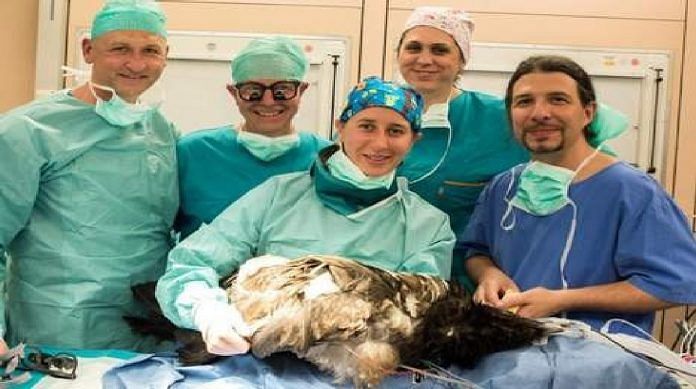
Vulture gets a prosthetic foot for the first time
For the first time, scientists have fitted a prosthetic leg onto a bearded vulture.
So far, all bionic aids have been used in humans. However, for the first time, the technique known as osseointegration (direct skeletal attachment) has been used in a bearded vulture.
In large birds such as vultures, the loss of limbs results in the loss of the ability to walk and ultimately leads to death from malnutrition. The limb can be replaced by a prosthesis but, so far, it has not been possible to use conventional prosthesis shafts in avian limbs, given the extreme loads they have to withstand in daily use.
The team from Vienna University of Veterinary Medicine had developed the world’s first fully-integrated bionic arm prosthesis last year. This is now ready to use and is described by the researchers as “Plug and Play”.
Bearded vultures are the largest flying birds in Europe with a wingspan of up to 2.6 m. This particular bird, nicknamed “Mia” from the Owl and Bird of Prey Sanctuary in Austria, had injured its foot so badly that it had to be amputated. So the team designed a special bone implant that could be surgically attached to the stump. Read more here
Spider hair reveals clues to developing strong adhesives
Scientists have for the first time described the characteristics of the hair-like structures that form the adhesive feet of the wandering spider Cupiennius salei, which may help design strong but reversible adhesives.
The research explains how spiders can walk straight up and even upside-down across so many different types of surfaces.
The feet of this species of spider are made up of close to 2,400 tiny hair or ‘setae’ — each a hundredth of one millimeter thick. Researchers collected a sample of this hair and then measured how well it stuck to a range of rough and smooth surfaces, including glass.
They also looked at how well the hair performed at various contact angles.
What the team found was that each hair showed unique adhesive properties. Under the microscope, each hair was different and had unrecognised structural arrangements. The team believes that this variety may be key to how spiders can climb so many surface types.
Although it is still very difficult to fabricate nanostructures like those of the spider, the team believes the research can help achieve the stability and reliability of the natural materials. Read more here
Coelacanths live for almost a hundred years
Coelacanths — enormous fish that live deep in the ocean — can live up to a hundred years, five times longer than earlier believed, a new study has found.
Researchers in France found that their oldest specimen of coelacanth fish, once thought to be extinct, was 84 years old. They also noted that coelacanths live life extremely slowly in other ways, reaching maturity around the age of 55 and gestating their offspring for five years.
The new age estimation also allowed the researchers to re-appraise the coelacanth’s body growth, which happens to be one of the slowest among marine fish of similar size.
Earlier studies attempted to age coelacanths by directly observing growth rings on the scales of a small sample of 12 specimens. Those studies led to the notion that the fish didn’t live more than 20 years. If that were the case, it would make coelacanths among the fastest-growing fish given their large size.
In the new study, researchers looked at coelacanths specimens ranging from embryos in utero to individuals of almost two meters. They were able to examine 27 specimens in all.
They also used new methods to estimate individuals’ age and body growth more precisely than before. More on it here
Earth’s energy imbalance doubled since 2015
The Earth’s energy imbalance approximately doubled during the 14 years from 2005 to 2019 — which means that the Earth is now trapping nearly twice the heat than it was about 15 years ago.
Earth’s climate is determined by a balance between how much of the Sun’s energy is absorbed in the atmosphere and at the surface and how much radiation Earth emits to space.
A positive energy imbalance means the Earth system is gaining energy, causing the planet to heat up.
Scientists at NASA and National Oceanic and Atmospheric Administration (NOAA) compared data from two independent measurements. NASA’s Clouds and the Earth’s Radiant Energy System (CERES) suite of satellite sensors measure how much energy enters and leaves Earth’s system. In addition, data from a global array of ocean floats called Argo enable an accurate estimate of the rate at which the world’s oceans are heating up.
Since approximately 90 percent of the excess energy from an energy imbalance ends up in the ocean, the overall trends of incoming and outgoing radiation should broadly agree with changes in ocean heat content.
Increases in emissions of greenhouse gases such as carbon dioxide and methane due to human activity trap heat in the atmosphere, capturing outgoing radiation that would otherwise escape into space.
The study finds that the doubling of the imbalance is partially the result of an increase in greenhouse gases due to human activity, along with increases in water vapour, which are trapping more outgoing longwave radiation, further contributing to Earth’s energy imbalance. Read more here
Subscribe to our channels on YouTube & Telegram
Why news media is in crisis & How you can fix it
India needs free, fair, non-hyphenated and questioning journalism even more as it faces multiple crises.
But the news media is in a crisis of its own. There have been brutal layoffs and pay-cuts. The best of journalism is shrinking, yielding to crude prime-time spectacle.
ThePrint has the finest young reporters, columnists and editors working for it. Sustaining journalism of this quality needs smart and thinking people like you to pay for it. Whether you live in India or overseas, you can do it here.